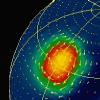 The long-awaited catalog of bursts observed by RXTE has finally been published in ApJS, and is also out on astro-ph/0608259. The preprint version omits the extended figures; click below for a full abstract, more complete versions, and data tables.
The long-awaited catalog of bursts observed by RXTE has finally been published in ApJS, and is also out on astro-ph/0608259. The preprint version omits the extended figures; click below for a full abstract, more complete versions, and data tables.
Abstract
We have assembled a sample of 1187 thermonuclear (type I) X-ray bursts from observations of 48 accreting neutron stars by the Rossi X-ray Timing Explorer, spanning more than 10 years. The sample contains examples of two of the three theoretical ignition regimes (confirmed via comparisons with numerical models) and likely examples of the third. We present a detailed analysis of the variation of the burst profiles, energetics, recurrence times, presence of photospheric radius expansion, and presence of burst oscillations, as a function of accretion rate. We estimated the distance for 35 sources exhibiting radius-expansion bursts, and found that the peak flux of such bursts varies typically by 13%. We classified sources into two main groups based on the burst properties: (1) both long and short bursts (indicating mixed H/He accretion), and (2) consistently short bursts (primarily He accretion), and we calculated the mean burst rate as a function of accretion rate for the two groups. The decrease in burst rate observed at >0.06ṀEdd (>~2×1037 ergs/s) is associated with a transition in the persistent spectral state and (as has been suggested previously) may be related to the increasing role of steady He burning. We found many examples of bursts with recurrence times <30 minutes, including burst triplets and even quadruplets. We describe the oscillation amplitudes for 13 of the 16 burst oscillation sources, as well as the stages and properties of the bursts in which the oscillations are detected. The burst properties are correlated with the burst oscillation frequency; sources spinning at <400 Hz generally have consistently short bursts, while the more rapidly spinning systems have both long and short bursts. This correlation suggests either that shear-mediated mixing dominates the burst properties, or alternatively that the nature of the mass donor (and hence the evolutionary history) has an influence on the long-term spin evolution.
ADS link
arXiv.org preprint
Preprint with complete figures (10 Mb PDF)
On-line version of table 5 via VizieR
ASCII version of the burst data (table 5 in the accepted version) + IDL template for use with READ_ASCII
ASCII version of table 9 (burst oscillation properties)
Labels: 2006, /thermonuclear bursts
 The XXIIIth Texas Symposium, held here in Melbourne, concluded last week. All in all a terrific success, with a very interesting program full of great talks by stellar (sorry) attendees. There were plenty of international visitors, many of whom commented on how much they enjoyed their visit despite the long trip. I managed to catch up with quite few people I hadn't seen for a while, but for most the social highlight was Thursday's dinner at the NGV's Garden Restaurant.
The XXIIIth Texas Symposium, held here in Melbourne, concluded last week. All in all a terrific success, with a very interesting program full of great talks by stellar (sorry) attendees. There were plenty of international visitors, many of whom commented on how much they enjoyed their visit despite the long trip. I managed to catch up with quite few people I hadn't seen for a while, but for most the social highlight was Thursday's dinner at the NGV's Garden Restaurant.


 On November 9th we had a fun morning following the progress of the
On November 9th we had a fun morning following the progress of the 
 We just had the first
We just had the first  The long-awaited catalog of bursts observed by RXTE has finally been
The long-awaited catalog of bursts observed by RXTE has finally been  For those in the local Astro group who may have an interest or a need to analyse some X-ray data from Chandra or RXTE, I have installed some analysis software (Linux machines only) and related calibration files in /data/software. For Chandra data analysis I have installed CIAO version 3.3.0.1, as well as the ISIS spectral fitting package version 1.3.1 and the CALDB files. For RXTE analysis I have installed HEASOFT version 6.0.3 and the appropriate CALDB files.
For those in the local Astro group who may have an interest or a need to analyse some X-ray data from Chandra or RXTE, I have installed some analysis software (Linux machines only) and related calibration files in /data/software. For Chandra data analysis I have installed CIAO version 3.3.0.1, as well as the ISIS spectral fitting package version 1.3.1 and the CALDB files. For RXTE analysis I have installed HEASOFT version 6.0.3 and the appropriate CALDB files.

